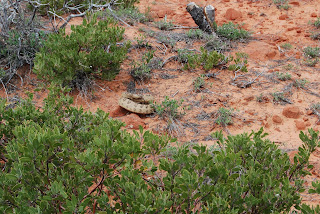The Desert Blooms!
All of us have special places we like to ride . Mine are found among the red rock canyons of
southern Utah. When the temperatures
approach 110 degrees, I retreat to the higher altitudes of the Colorado
Plateau. June through September I enjoy
the cool breezes wafting across alpine meadows while watching my horses graze
at 9,000 feet. Early June finds me on
the Boulder Mountains checking the spring pronghorn antelope hatch or riding
among the cow elk with their recently born calves.
Globe Mallow and Prickly Pear
While I love the High Plateau Country, there is nothing like
the desert Southwest in full bloom. It
doesn’t last long - maybe two weeks or so - but the profusion of wildflowers is
incredibly beautiful. After an unusually
wet winter, the desert floor is a carpet of orange, yellow, pink, red, and
blue. For years, I have packed my Field Guide to the Southwestern States
in my pommel bags with the intent to identify more species by name. After all these years, I still only know a
few at first glance such as globe mallow, Indian paintbrush, sego lily,
creosote bush, and a few others.
While I struggle with the names of various plants and
wildflowers, I don’t need my field guide to identify Crotalas virdis lutosus –
the Great Basin Rattlesnake. Utah is
home to seven different venomous species, and the Great Basin Rattler is the
most common. For some unknown reason, I
can’t seem to ride anywhere this spring without finding another
rattlesnake. My riding buddy “The
Reverend” Cline now calls me the “Snake Charmer.” Doc Johnson has started to avoid me to
concentrate on his golf game.
Globe Mallow and Prickly Pear
While I love the High Plateau Country, there is nothing like
the desert Southwest in full bloom. It
doesn’t last long - maybe two weeks or so - but the profusion of wildflowers is
incredibly beautiful. After an unusually
wet winter, the desert floor is a carpet of orange, yellow, pink, red, and
blue. For years, I have packed my Field Guide to the Southwestern States
in my pommel bags with the intent to identify more species by name. After all these years, I still only know a
few at first glance such as globe mallow, Indian paintbrush, sego lily,
creosote bush, and a few others.
While I struggle with the names of various plants and
wildflowers, I don’t need my field guide to identify Crotalas virdis lutosus –
the Great Basin Rattlesnake. Utah is
home to seven different venomous species, and the Great Basin Rattler is the
most common. For some unknown reason, I
can’t seem to ride anywhere this spring without finding another
rattlesnake. My riding buddy “The
Reverend” Cline now calls me the “Snake Charmer.” Doc Johnson has started to avoid me to
concentrate on his golf game.
Even my four-year-old Aussie Maynard has started avoiding
me. He spent a recent May evening at the after hours emergency vet after being bitten by a snake. Fortunately, his bite wasn’t terribly serious
and only suffered a swollen muzzle for a few days. He has now completed the rattlesnake
vaccination series recommended by the vet, and is scheduled to attend
rattlesnake avoidance training in a few weeks.
Until then, he stays home while I ride the desert to enjoy this year’s
wildflower bloom.
From what I understand, Great Basin Rattlers are naturally
shy, sit and wait predators. They don’t
go looking for trouble, but I doubt Maynard would agree. Unless provoked they will quietly let you
pass or try to retreat. Knowing my dog,
I’m quite sure he provoked the one who bit him.
I have encountered hundreds of rattlers over the years, and the
description of their behavior is consistent with my experience. Don’t bother them and they won’t bother you.
I’m often asked about whether I kill the snakes I literally
stumble across. While I readily admit
that I don’t seek their company, I always let them go. At my age, I’m at greater risk dismounting
from my horse with a snake around in rough country than the chance of having my
horse or dog bitten. In fact, killing
one in Zion National Park where I ride frequently is a federal offense, and can
lead to legal action and a substantial fine.
Also, though most people in Utah aren’t aware, the Great Basin Rattler
is a protected species. It is illegal to
kill them unless you, your pets, or property are threatened.
So, what do you do? Stay home until they hibernate again in
October? Not me, my horses, or my
dog. March through September we take
extra precautions to avoid serious snake encounters. I watch where I sit and put my feet, and now
have my dog vaccinated at the start of active snake season. Until recently there wasn’t a vaccine for
horses. From what I have read, there is
a three-shot series given 30 days apart if you have serious concerns about your
horses getting bit. I haven’t seen the
need yet even though I live and ride in snake country. According to the literature, very few horses
die from rattlesnake bites, but it’s imperative to immediately seek
veterinarian assistance if your horse or dog is bitten even if they are
vaccinated. Staying calm and finding
help isn’t easy to do 10 or fifteen miles from your truck, but don’t stay
home. Get out there and ride!

